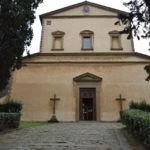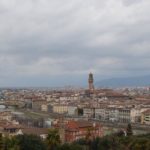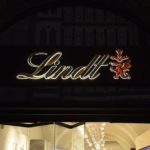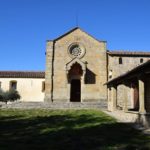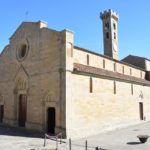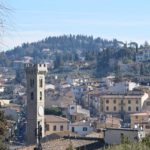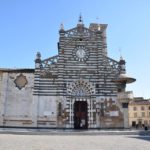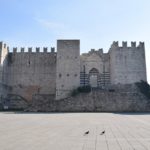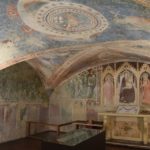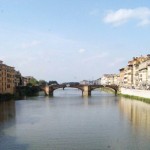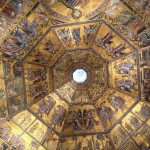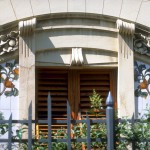Slow tour from the Cathedral to the Old Bridge
An itinerary through Florence and the nearby
A week discovering Florence, Fiesole and Prato
I had a luck-filled journey here. My flight went Hartford-Montreal-Brussels-Milan-bus to Milan Central Station-train to Florence. A long day hopping around! It was pouring when I got here but I am a 15-minute walk from the train stain and 2 minutes walk from the Dome. I am drinking coffee, loving my apartment, and about to go out and take a few photos.
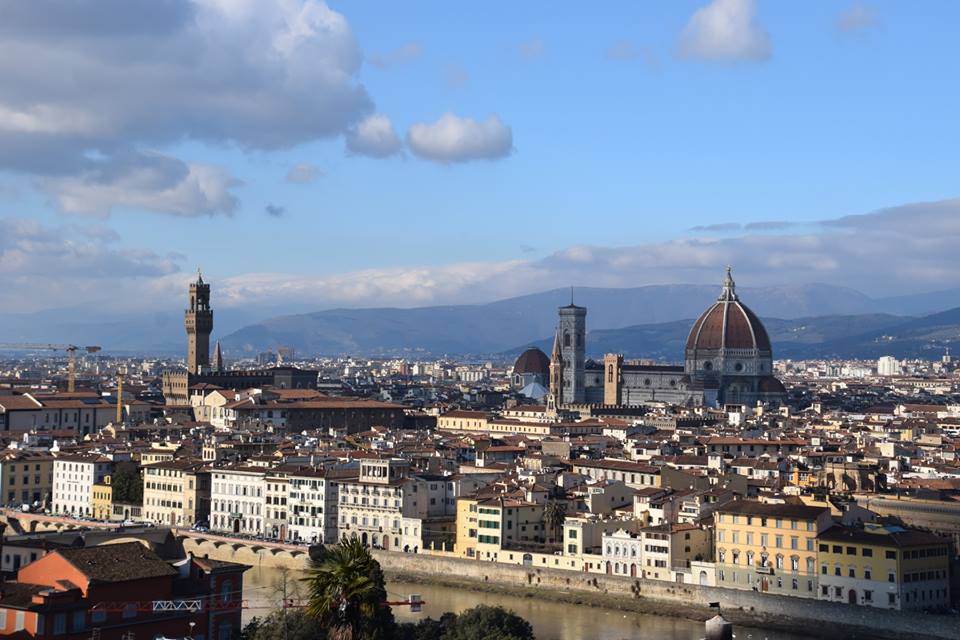
Landscape, Florence -Virginia Merlini
Florence – Day 1
The Uffizi Gallery, the Botticelli Room. As you can imagine, this room is VERY popular and the Uffizi swarms with visitors even off-season. I had a fabulous and site-filled day that included over six hours in the Uffizi, a 400-step climb to the top of the Campanile (my calves are screaming at me), and a great walk to the Basilica Di Santa Croce and around the medieval center of Florence. I am off to the Palazzo Pitti and the Giardini Boboli tomorrow!
FYI – Sandro Botticelli was born in Florence, Italy as Alessandro di Mariano di Vanni Filipepi (1445/1510) on the Via del Porcellana – two bridges north from the Ponte Vecchio and across the River Arno from the Chiesa di San Frediano in Cestello – the church founded by the same order of monks for whom he painted an Annunciation included here. Botticelli was a Pisces! He was an unhealthy and melancholic, self-absorbed child, the youngest of four brothers born in a family of craftsmen. He trained with the great Filippo Lippi (1406-1469), a handsome, strong-featured youth who grew to be a chubby-faced genius and whose paintings I adore. Bottecelli’s colors are both vibrant and muted and there is something of romance and gentleness in the way he paints.
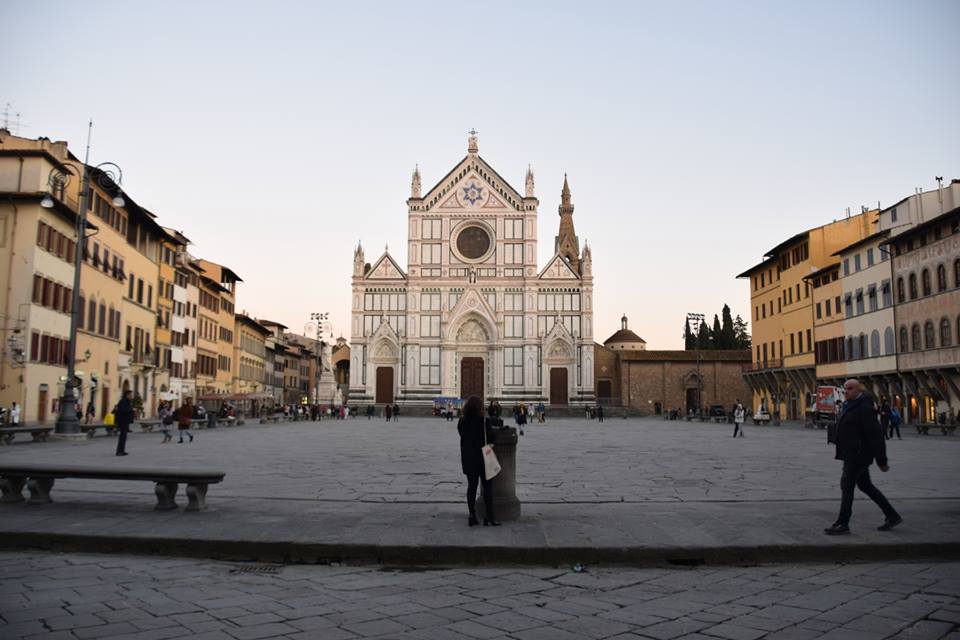
Basilica Santa Croce, Virginia Merlini
I spent the afternoon in the Basilica di Santa Croce, a church which hosted St Francis of Assisi in 1212. It was more than worth the €8 ticket needed to purchase access to its altars, sixteen family chapels, cloister complex with three cloisters, frescoed sacristy, completely frescoed refectory with its astonishing Tree of Life painted in 1350 by Taddeo Gaddi, museum, and tombs and cenotaphs of the Florentine great. Here are the three Donatello sculptures, a detail from Bronzino’s gorgeous painting of Christ descending into limbo, the four most important tombs, and ten golden Madonna’s (all 14th century).
Mercato Centrale! What a find! This is the central market in Florence and it is fabulous! I had a Panino Porchetta for lunch and shared it with a fearless sparrow who simply ate my sandwich – even taking the bread out of my hand. It was 59 F / 15 C today and I had a wonderful time in the San Marco museum looking at the gorgeous frescoes and paintings of Fra Angelico. I, also, spent some time in the ancient Basilica di San Lorenzo, consecrated by Milan’s Saint Ambrose in 393!
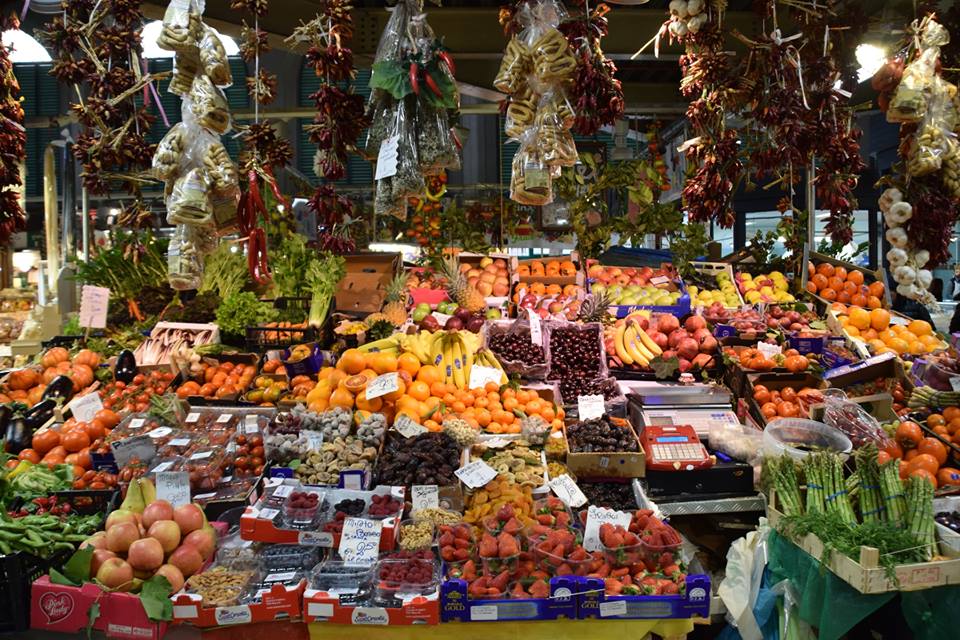
Central Market, Florence -Virginia Merlini
Museo di San Marco – Savonarola – What makes this very inexpensive €4 museum special besides that it is filled with the colorful and beautiful art of Fra Angelico (1395/1455) is that one gets to see how the monks lived because the convent and their cells are accessible to the public. Each cell has a painting by Fra Angelico and/or his helpers. But I wanted to share a very well – known painting of Savonarola – the famous monk who was prior of this convent, a critic of the Catholic hierarchy in Rome, a theologian and writer of renown, the de facto ruler of Florence for four years, and famously hung and burned in the Piazza Signoria in May of 1498. The painting, which I am sure most of you have seen, hangs here. One can never forget the hooked nose profile of this controversial monk. I had no idea Savonarola lived here nor did I know this painting was in the museum. It was truly a treat! Fra Bartolomeo (1472/1517) painted it.

Painting by Fra Bartolomeo, Virginia Merlini
Florence – Day 2
I decided I wanted to walk and enjoy the city rather than visit museums and churches. I failed! My all day walk took me many places but most notably to two 13th-century churches. So, from the Basilica di Santo Spirito, here are some wonderful 15th-century Madonna’s and the gorgeous lime-wood crucifix carved, painted, and donated by an 18-year old Michelangelo grateful for being allowed to study corpses there before their burial. And from the Basilica di Santa Trinità where a vigilant, short, elderly, overweight monk kept his eagle-eyes on us to prevent picture taking are a gorgeous Annunciation and Adoration of the Magi. I was particularly sore-hearted at Santa Trinità which was filled with frescoed chapels and fully restored and brightly colored 14th and 15th century Madonna’s – my favorite.
On my way to the Bargello – a magnificent sculpture museum filled with Donatello’s and four Michelangelo’s – I came across this gorgeous Wall Madonna, an Annunciation. Because I stopped I happened to see the sign for Dante’s Church! Opened in 1032 this church is where Dante first saw his muse Beatrice Portinari who comes down from Heaven to say “hello” and eventually lead him through Paradise in his Divine Comedy. Beatrice’s tomb is there. This city of just too romantic!
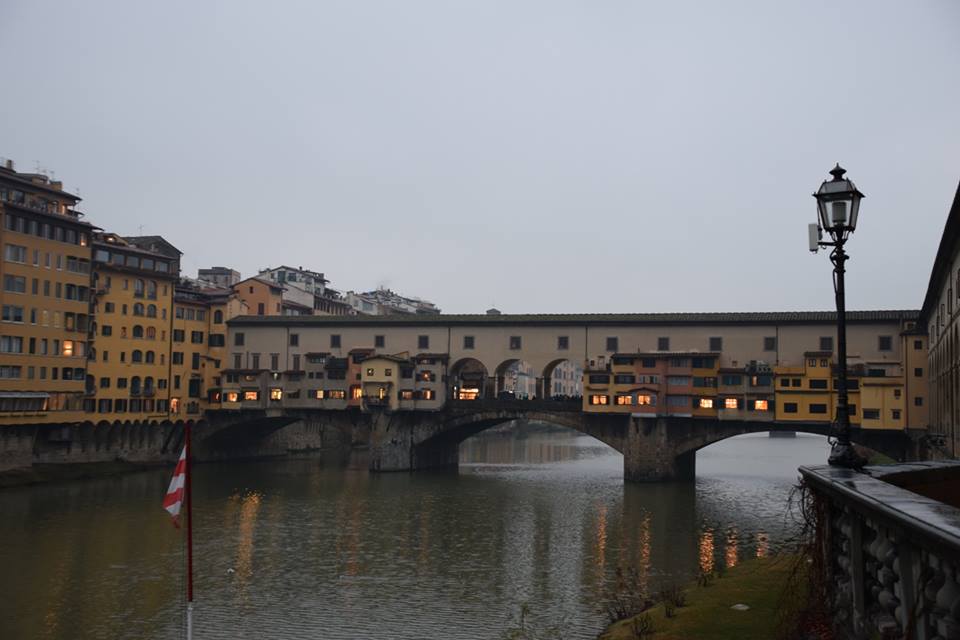
Ponte Vecchio, Florence -Virginia Merlini.
I went to Orsanmichele in order to buy a ticket to the Academia, the art gallery that has Michelangelo’s David. Because it was free and I was there I visited the church of Orsanmichele. There is a really interesting history surrounding the building which was not a church when constructed in 1337. Originally this was a loggia – an open-air grain storage facility and market. The first floor was dedicated to commerce, the second floor to merchant guild offices, and the third floor housed the grain to keep it safe from sieges and in times of famine. There were two hollow pillars that ran from the third floor to the first floor and grain was poured down them for sale. Each guild paid a renowned sculptor to carve a larger than life statue of a saint which was then housed in its own niche on the outside of the building. Two of the statues were carved by the great Donatello – St Mark and St George. Now the originals are on the second floor displayed for the public to see and copies were put in the niches. The third floor is a large hall with ten really awesome wooden benches made out of what had to be huge trees. The public can step up on the stone benches that line the walls under the windows of the old market to see a great view of Florence. Or one can sit on the benches and enjoy the space and peaceful atmosphere. The building’s bottom floor was walled and converted into a church between 1380 and 1404. The church is non-conventional because of its original purpose. The building is divided in two and there are two altars and no side chapels. It is richly dedicated with beautiful frescoed ceilings and pillars. The left altar is dedicated to St Anne and there is a sculpture of St Anne and the Virgin Mary and Jesus carved by Francesco da Sangallo. The right side altar is dedicated to the Virgin Mary. There is a 1346 painting of the Virgin and Child with Angels by Bernardo Daddi (1280-1348). The church has a really nice ambiance and is very lovely. I will go back to look at the beautiful artwork.
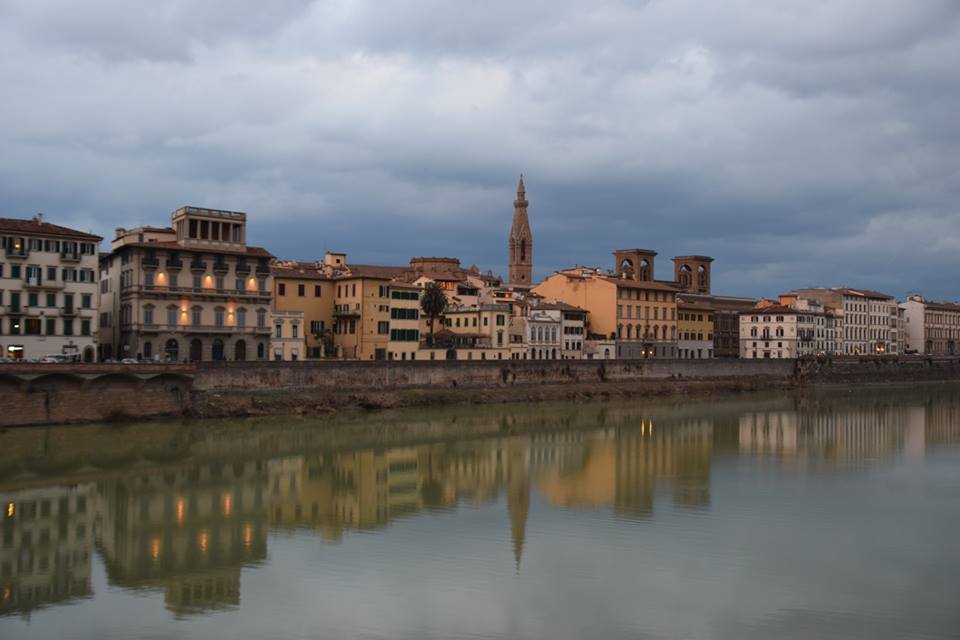
Florence, Virginia Merlini
Florence – Day 3
Chiesa di San Salvatore al Monte! Other than being at the top of the hill behind Piazzale Michelangelo with a fabulous view of Florence (where I walked to see the sunset) and being next to the elaborately embellished San Minato with its green and white marble façade and 8th century frescoes, San Salvatore is a non-descript church built using the common Florentine brown pietraforte and devoid of external (and internal) embellishment save for the Stemma of the merchant who paid for her – Castello Quaratesi. Its large central aisle leading to an unadorned altar is lined with five dark chapels on each side all decorated with similarly dark – and large – paintings of the 16th and 17th-century – not original to the church. But – with patience and a discerning eye there are true treasures that await!
There are two beautiful ceramic Depositions by Giovanni della Robbia (1469-1529) filling the lunette above the side entry door and another in a side chapel, and five paintings from Fra Angelico’s era (my preferred mid to late Gothic era with its bright colors and natural figures). But the offerings that make it worthy of the climb are the most fabulous stained glass windows – original to the church and from the early 1500’s. Michelangelo called this church the ‘comely peasant girl’ and she is but for the artfully crafted windows and – of course – the original Gothic art. An underwhelming church with a few pieces of exquisite art served to overwhelm what I thought would be an uneventful walk. I missed this church the last time I walked here and today my curiosity got the better of me. I am glad it did! Because the sun was shining on the west, the east side stained glass is not illuminated. But it is still gorgeous! Can you imagine – glass from the early 1500’s – 500 years old! These windows were at the top of the ten chapel ceilings. One was missing leaving nine plus the window above the main altar. San Salvatore is built on the site of an older Franciscan church originally dedicated to the 3rd-century martyrs the Cosimo and Damiano who were doctors, Arabs, brothers, and twins.
- Chiesa San Salvatore al Monte, Virginia Merlini
- Landscape Florence, Virginia Merlini
- Lindt, Florence -Virginia Merlini
Galleria dell’Academia – some lovely Annunciation’s. Most Catholic and much Christian religious art has an Annunciation painted in the predella of paintings or the gables of altarpieces. Except for the 1335 Taddeo Gaddi “Annunciation” which is a gable panel in his large Storie di Cristo – Story of Christ, these were the central theme of the painting.
This is where I ended my day – LINDT CHOCOLATES! The chocolatier we all know as Lindt is actually called Chocoladefabriken Lindt & Sprüngli AG. It was founded in 1845 and the $4 billion company has been making chocolates and other sweets since then. Their market is global and the delicious products are why! The chocolate sold in Italy is made here – in Lombardy in a small town of 10,000 called Induno Olona in the Province of Varese. The company has a fabulous store located right on the Piazza del Duomo. They have a cafe that serves coffee and treats and the store offers discounts for purchases of chocolate weighing 1 kilo (2.2 pounds) or more. I bought my 200 grams of chocolate balls (€4.59 per 100 grams) after a group of Japanese teens checked out with about 5 kilos of chocolate each! Beautiful and beautifully dressed they were fun to watch fill up their bags – grabbing handfuls of different chocolate balls and chocolate hearts. Just FYI – the cashier spoke English to the Japanese teens and Italian to me!
Fiesole – Day 4
I spent the day in Fiesole today. Just a scant 4 miles from Florence, this pretty hill town reminded me of Umbria and it was a peaceful escape from the wild crowds, bustle, and noise of Florence. The views from the piazza just below the 14th-century Franciscan monastery were astounding. I met a fabulous Italian couple while admiring a huge Andrea della Robbia (1435-1525) ceramic crucifixion in the ancient (996AD) Chiesa Santa Maria Primerana in the center of town. There is a Roman forum here but it was too pricey for me and I took a stroll down Via Marini and saw it from a distance for free! The bus ticket to get here was €3 roundtrip and the drive to the top of the hill was fabulous.
- Fiesole, Virginia Merlini
- Fiesole, Virginia Merlini
- Fiesole, Virginia Merlini
Prato – Day 5
I had a wonderful day in Prato yesterday. It is the second largest town in Tuscany and known for its textiles and biscotti called ‘cantucci’. The central train station is located across the River Bisenzio. Just a brief walk straight ahead gets one to the Dome. It is worth the ten-minute stroll to have the pleasure of seeing the modern fade to the Medieval as one reaches the tiny old churches and come face-to-face with the bright white limestone Imperial Castle of Holy Roman Emperor Frederick II. This is a great one day city that offers plenty of free sights and others that give one much more than would be expected from the low prices. For €5 one can see the chapel frescoed by Filippo Lippi in the 1400’s as well as the museum which gives one access to the ancient frescoed vaults beneath the cathedral, the 12th-century cloister and the large and impressive art collection – and the Campanile when it is open.
- Prato, Virginia Merlini
- Prato, Virginia Merlini
- Prato, Virginia Merlini
Last day in Florence
Mercato La Cascine – I went to the Tuesday street market in the huge (almost 400 acres) Parco delle Cascine where I finally tried the famous Florentine street food – Lampredotto. Lampredotto is the cow’s fourth or last stomach. Where tripe is eaten elsewhere – in the US too – lampredotto is exclusive to Florence. It is slow cooked for hours with carrot, celery, onions, tomatoes, and parsley. It is served on a soft bun dipped in the lampredotto broth and served with Italian salsa verde made with anchovies, parsley, vinegar, garlic, capers, onion and a spicy red sauce made with hot pepper flakes and olive oil. It is a sloppy panino best eaten with red wine and lots of napkins. It is yummy and unique! I will make it when I get home!
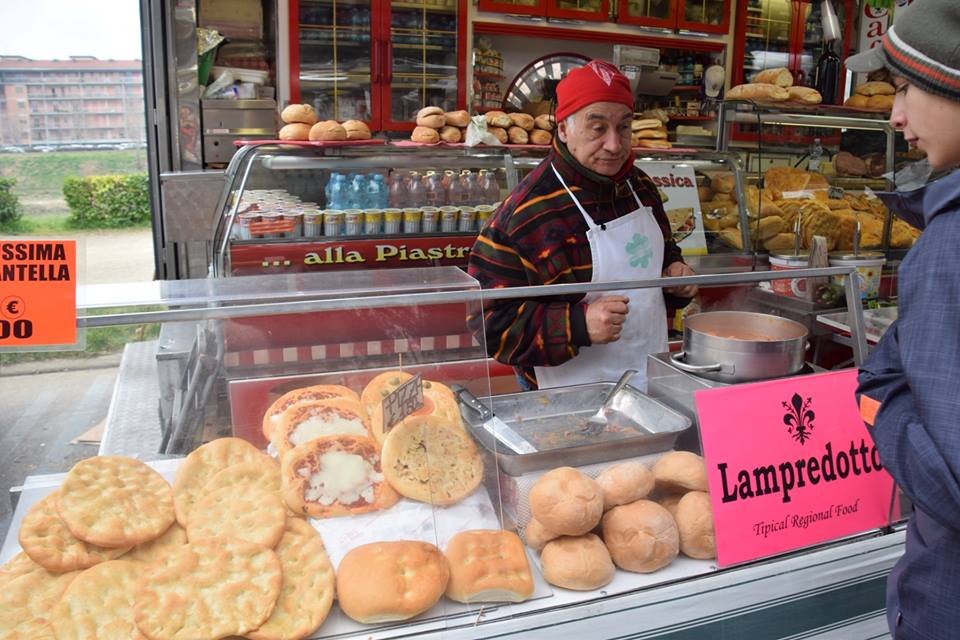
Lampredotto, Virginia Merlini
Virginia Merlini

